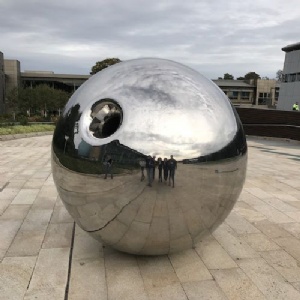
Art meets Science at the Wellcome Genome Campus
Published on 17/10/17

On 4 October our Lower 6th A Level and IB Art students joined a workshop to launch a project exploring the connections between Science and Art, hosted by Dr Alice Clark at the Wellcome Genome Campus, in Cambridge.
 At the Stephen Perse Foundation, our approach to learning provides plenty of opportunities to explore how subjects connect in the real-world, opening up new ways of thinking and different perspectives.
At the Stephen Perse Foundation, our approach to learning provides plenty of opportunities to explore how subjects connect in the real-world, opening up new ways of thinking and different perspectives.
The workshop Science and Art workshop was delivered by scientists working at the Protein Data Bank in Europe (PDBe), a resource for the collection, organisation and dissemination of data on biological macromolecular structures. Students learnt about the process involved in mapping Proteins and examined how DNA makes proteins, the functions of symmetry in Biology, how proteins can inspire art and the visualisation techniques used to launch their first project.
Students also toured the Wellcome Genome Campus, meeting scientists developing DNA sequencing using portable scanners used on the European Space Station. As part of their activities students attended a lecture by a Bio-Chemist on symmetry in Viruses and made a three dimensional model of a virus protein.
Opportunities for learning at the Wellcome Genome Campus are phenomenal. It is home to world-leading scientific organisations in genomics and computational biology, and it committed to delivering life-changing science with the reach, scale and imagination to solve some of humanity’s greatest challenges. Insitutes and organisations on Campus include the Sanger Institute, EMBL-EBI, Connecting Science, YourGenome, a Conference Centre and the BioData Innovation Centre.
This launch workshop will be followed up by additional activities with the PDBe, culminating in an exhibition of work in summer 2018.
Annabel and Rebecca, two Lower 6th Form students who attended the workshop reflected on its impact: "As artistic individuals, learning about something out of our comfort zone helped us to get to know one another. It was an excellent opportunity for photography, as although we were not allowed to take photos in certain buildings there were mirrored sculptures, representing embryos in different stages of development, that held great aesthetic appeal. Overall the trip was interesting as an artist as although some of it went over my head, it has sparked new ideas in many of us and it was interesting to see an aesthetic perspective on something we've traditionally viewed as very factual, logical, and different to art."




Overall the trip was interesting as an artist as although some of it went over my head, it has sparked new ideas in many of us and it was interesting to see an aesthetic perspective on something we've traditionally viewed as very factual, logical, and different to art."
“